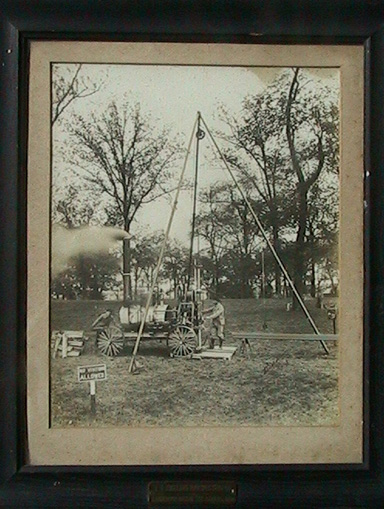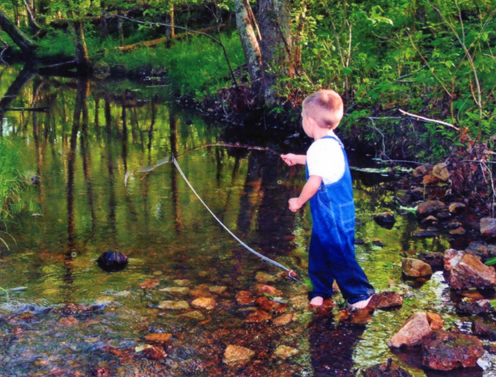Deep Drill No.1..."Then Came That Sound...the sound of water!"
The Artesian Well

Deep Drill No.1
1914: The Valle Mining Company decides to prospect for lead ore but much deeper down than its 100 ft.
surface mines, this time hundreds of feet deep, down into the Bonne Terre Formation, perhaps to find
the Viburnum Trend lead and its unlimited wealth. But The Question: "Does the Trend reach this far
north into our Southeast Missouri Lead Belt?"
At the time, a steam-powered diamond core drill was the only technology that could find out.
At first, the day's drilling proved nothing. Over and over, the decision came down. "We'll go deeper!"
100, 200, 400, 800 feet deep they drilled, still nothing. Then came that sound...the sound of water!
At 840 feet they struck an underground river. What was once a dry drill hole transformed in seconds
into a river. Water gushed out at 75 gallons per minute, enough to fill a modern day drywall bucket
in 4 seconds.
It took 50 years for the Missouri Dept. of Natural Resources to trace the source
of the water 200 miles south, back to an underground river in Arkansas. That river feeds this well
from deep within the aquafer to this day. People drive hundreds of miles, even
from Illinois [farthest visitors: New Zealand!], to fill their water jugs. The oldest man in town
attributes his old age to the water, drinking it every day. To see how pure it really is and what's in it,
Click Here
The Well continues to flow 109+ years later. Even during the worst droughts, the well
continues to produce.
 It drains nearby into the creek
which has the perfect pool (3 feet deep) to the left for training new anglers or just
getting kids wet on a hot day (watch the rocks, they can be slippery).
It drains nearby into the creek
which has the perfect pool (3 feet deep) to the left for training new anglers or just
getting kids wet on a hot day (watch the rocks, they can be slippery).
A video.
105+ years later, even during the worst drought, the well continues to produce. Nearby
wells recently have diminished its volume but the purity and rare flavor endures to this day. A great place for a
microbrewery if you know someone who wants to start one.
The Two Mysteries of Drill Hole No.2
Deep Drill No.2 According to logs, not only did the driller strike an underground river
in Drill Hole No.1 but next, and only a mile away by the Big Lode Mine, he struck a huge deposit of lead
in Drill Hole No.2 when he brought up a core that had drilled
through 6 feet of lead. Although the largest hand-mined lead nugget at Valles Mines proved to be,
conversationally, the size of a Volkswagen Beetle, this discovery would have rated as even bigger.
The Company never pursued this prospecting discovery, trying first to follow up on the zinc discoveries
in hopes of extending the Garotte
Mines. As Fate would have it, instead, all operations ended and the miners
sent home as a result of an all-important
Edgar Zinc smelter closing in Carondolet where energy had been cheap from
widespread oil exploration before the European war effort, that is,
until demand peaked with war in Europe in 1914, even though America came in late in 1918.
Even as the Western Front began to freeze in autumn 1914, mobile warfare became more
and more important.
This setback to the Company got an added contributing factor from 1917:
a labor shortage when 4 million able-bodied men [read: our miners] got drafted and sent to
WW I overseas, and who, in 1918-1920, brought back the Spanish Flu Pandemic, as well as
204,000 wounded,
and 116,708 dead.
While Drill Hole No.2's precise location has been lost, based on old surveyed maps it is located about 100
feet south of the Frazier Quarry (formerly the "Big Bill" Mine's twin shafts) towards the Big Lode Mine.
The precise depth of the strike, if determined, has been lost to history. Deep Drill No.2 remains a project
for a metal detector as the 10 foot tall iron casing that guided the drill remains in place waiting for
its rediscovery.
Of course it remains speculation but perhaps they should have taken up
Mr. Finney's offer to pump the flooded Garotte Mine at Drill Hole No.6 in 1911. That zinc mine never
was mined and its location is well known.